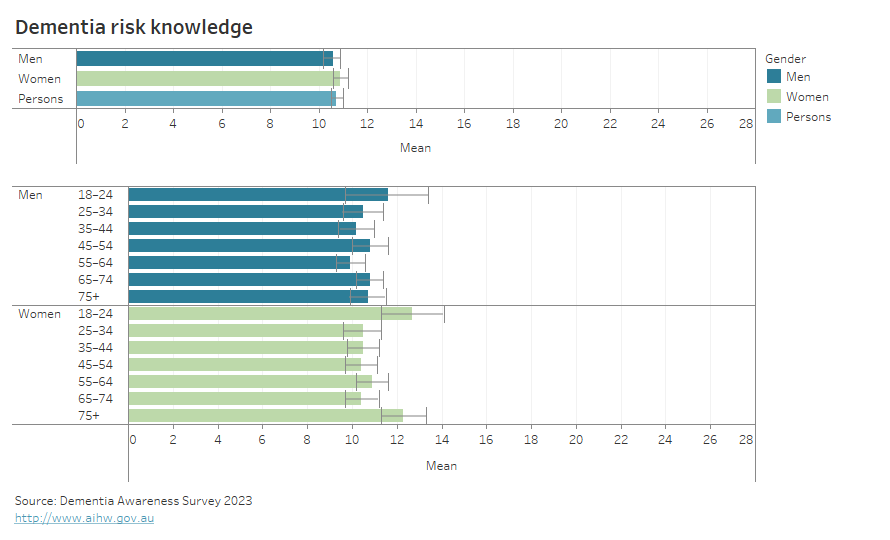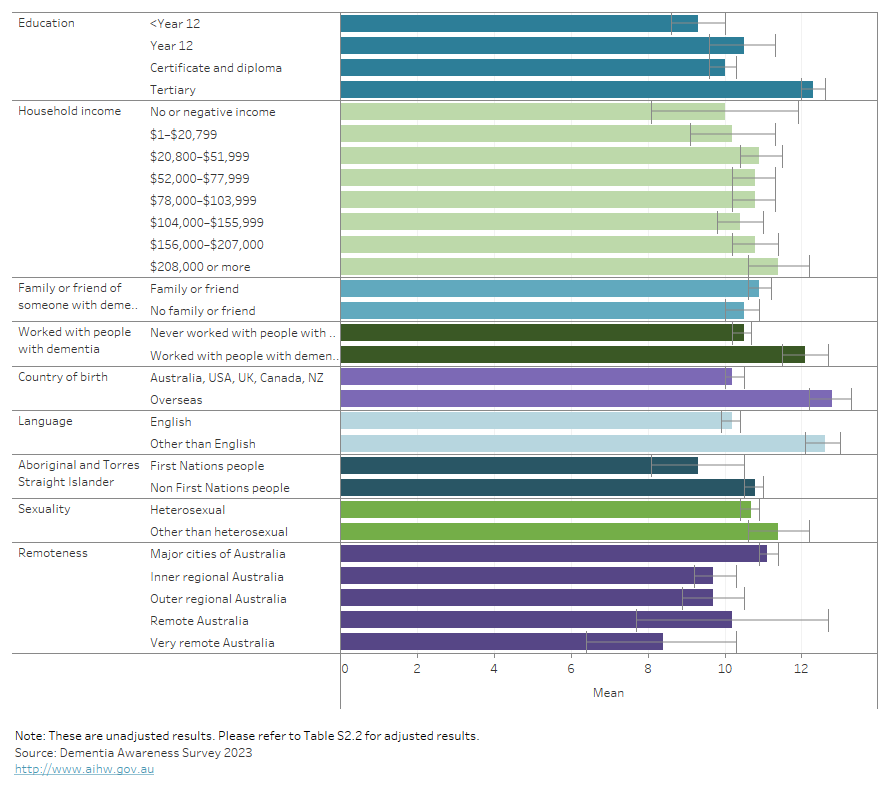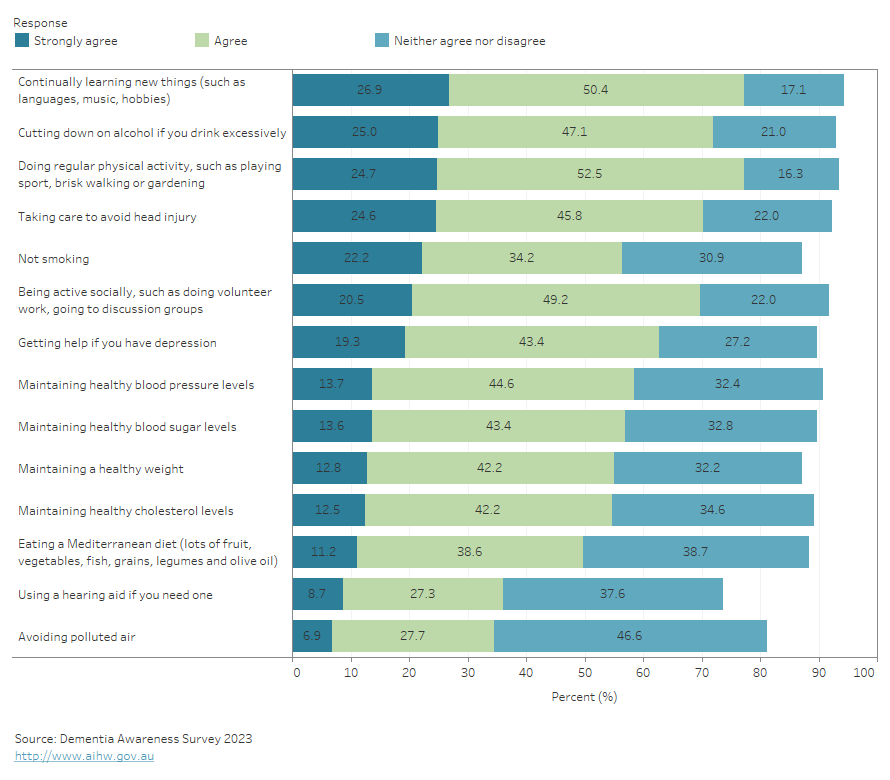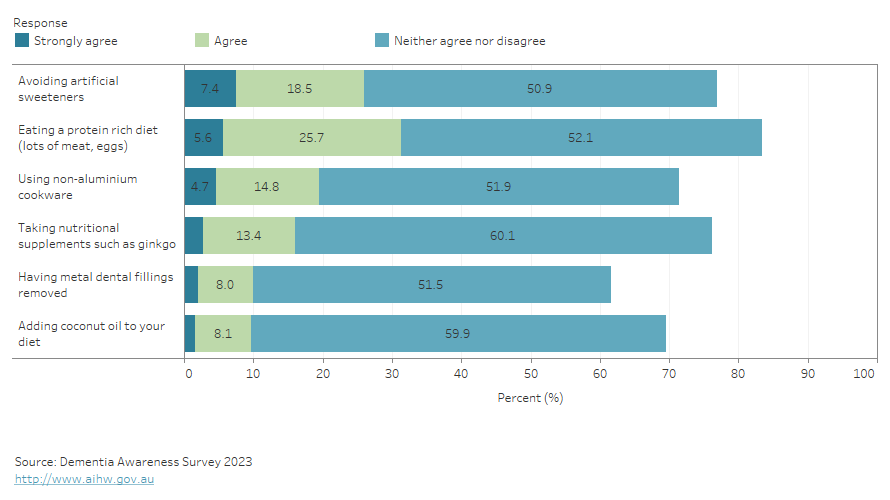Knowledge of dementia risk factors and misconceptions
Several factors may increase or decrease a person’s risk of developing dementia which are called risk and protective factors, respectively. Some risk factors, such as ageing and genetics, cannot be changed, but others can be modified by changing behaviours or lifestyles. See What puts someone at risk of developing dementia? for more information.
How is knowledge of dementia risk factors and misconceptions measured?
Knowledge of dementia risk factors was measured with the Knowledge of Dementia Risk Reduction (KoDeRR) scale (Bartlett et al. 2022), measuring knowledge of dementia risk factors as well as common misconceptions. The KoDeRR risk score (KoDeRR_R) was calculated by summing 14 known risk factors of dementia1, ranging from 0–28, and a higher score represents a better ability to recognise dementia risk factors. Similarly, the KoDeRR misconception score (KoDeRR_M) was calculated by summing 6 common misconceptions of dementia, ranging from 0–12, and a higher score represents a better ability to recognise misconceptions. Refer to the Technical notes for more information on the scale.
1. The KoDeRR items were developed primarily based on the review papers (Livingston et al. 2017, 2020) and WHO recommendations (2019). At the time it appeared that there was strong evidence to support the use of hearing aids for dementia risk reduction. However, the evidence is currently under reconsideration (Lin et al. 2023).
How much do Australians know about dementia risk reduction?
Australians had an average risk score (KoDeRR _R) of 10.7 (out of 28) and a misconception score (KoDeRR _M) of 2.0 (out of 12), suggesting Australians’ knowledge of evidence-based ways to reduce modifiable risk factors and ability to identify misconceptions about ways to reduce dementia risk was low. The levels of dementia risk knowledge and misconception knowledge were similar for men and women and for different age groups (Figure 2.1).
Figure 2.1: Dementia risk knowledge and misconception scores by gender and age group, 2023
The horizontal bar charts show similar scores for all genders and age groups, with women and the youngest and oldest age groups having slightly higher scores than men and other age groups.

How does dementia risk knowledge vary among population groups?
People’s knowledge of dementia risk and protective factors was compared among different socioeconomic groups as well as exposure groups (those without any relationship with people living with dementia; those living with dementia; those who know someone with dementia; and those who care (formally and informally) for someone living with dementia) (Figure 2.2).
Figure 2.2: Dementia risk reduction knowledge and demographics, 2023
The bar chart shows that those who were born overseas had the highest dementia risk knowledge (13), while respondents in very remote Australia had the lowest (8.4).

Dementia risk knowledge was compared within sociodemographic groups (refer to Table S2.2). After adjusting for other demographic factors, knowledge of dementia risk factors was significantly higher among:
- those aged between 18 and 24
- women (Figure 2.1)
- those with a Bachelor’s degree or above
- those who worked with people with dementia
- those who had a family member or friend with dementia
- non-heterosexual people
- those who spoke languages other than English at home.
Being born overseas, being First Nations people, and level of household income did not significantly contribute to the level of dementia risk knowledge.
Do Australians recognise dementia risk factors?
The survey outlined key modifiable risk and protective factors of dementia to seek levels of dementia risk knowledge. The number and percentage of people who correctly recognised dementia risk and protective factors are shown in Figure 2.3 below. The most identified ways to reduce the risk of developing dementia included being physically (77%), cognitively (continually learning new things; 77%), and socially active (70%) along with cutting down alcohol consumption if they drink excessively (72%) and preventing head injuries (70%). A large proportion of Australians were able to recognise key dementia risk factors, but most of these people answered with ‘agree’ rather than ‘strongly agree’, suggesting Australians may not be confident about what they know about dementia risk factors.
Only about 1 in 3 Australians (35%) knew that avoiding polluted air could reduce their risk of dementia.
Respondents in this survey recognised more modifiable dementia risks than a 2005 Australia study (Low and Anstey 2009) where respondents suggested dementia risk factors such as mental exercise (39%), physical exercise (30%), socialising (14%), and not smoking (5.7%). This may suggest that dementia risk knowledge has improved over time, or that recognition of risk factors is higher when respondents are provided prompts (such as risk factor statements) than when identifying risk factors without any prompts.
Figure 2.3: Number and percentage of people who recognised evidence-based modifiable dementia risk and protective factors, 2023
The stacked bar chart shows that most respondents selected ‘agree’ (28% to 50%) for the majority of the risk and protective factors.

How much do Australians know about dementia misconceptions?
There are common misconceptions about the things that affect a person’s risk of dementia such as that cooking in aluminium pots and pans can lead to dementia.
Many people did not correctly answer questions about misconceptions about ways to reduce dementia risk. The number and percentage of people who did not correctly identify common misconceptions of dementia are shown in Figure 2.4. The most common misconceptions believed by Australians was that eating a protein-rich diet could lower the risk of dementia (31%), followed by avoiding the use of artificial sweeteners (26%) and aluminium cookware (20%).
Belief in the misconception that aluminium cookware is a risk factor for dementia was lower in this survey (20%) than in a 2005 Australian survey (55%; Low and Anstey 2009). This indicates that while recognition of some dementia risk misconceptions has improved over time, misconceptions among Australians persist.
More than half of people (51% to 60%) were also unsure whether these misconceptions were true or false (answered ‘neither agree nor disagree’) suggesting that greater awareness of the evidence-based risk factors for dementia is needed.
Figure 2.4: Percentage of people who hold common misconceptions of dementia, 2023
The stacked bar chart shows how 62% to 83% of respondents either strongly agreed, agreed or neither agreed nor disagreed with the common misconceptions.

Bartlett L, Doherty K, Farrow M, Kim S, Hill E, King A, Alty J, Eccleston C, Kitsos A, Bindoff A and Vickers JC (2022) ‘Island study linking aging and neurodegenerative disease (ISLAND) targeting dementia risk reduction: protocol for a prospective web-based cohort study’, JMIR Research Protocols, 11(3):e34688, doi:10.2196/34688.
Lin FR, Pike JR, Albert MS, Arnold M, Burgard S, Chisolm T, Couper D, Deal JA, Goman AM, Glynn NW, Gmelin T, Gravens-Mueller L, Hayden KM, Huang AR, Knopman D, Mitchell CM, Mosley T, Pankow JS, Reed NS, Sanchez V, Schrack JA, Windham BG and Coresh J (2023) ‘Hearing intervention versus health education control to reduce cognitive decline in older adults with hearing loss in the USA (ACHIEVE): a multicentre, randomised controlled trial’, The Lancet, 402(10404):786–797, doi:10.1016/S0140-6736(23)01406-X.
Livingston G, Sommerlad A, Orgeta V, Costafreda SG, Huntley J, Ames D, Ballard C, Banerjee S, Burns A, Cohen-Mansfield J, Cooper C, Fox N, Gitlin LN, Howard R, Kales HC, Larson EB, Ritchie K, Rockwood K, Sampson EL, Samus Q, Schneider LS, Selbæk G, Teri L and Mukadam N (2017) ‘Dementia prevention, intervention, and care’, The Lancet, 390(10113):2673–2734, doi:10.1016?S0140-6736(17)31363-6.
Livingston G, Huntley J, Sommerlad A, Ames D, Ballard C, Banerjee S, Brayne C, Burns A, Cohen-Mansfield J, Cooper C, Costafreda SG, Dias A, Fox N, Gitlin LN, Howard R, Kales HC, Kivimäki M, Larson EB, Ogunniyi A, Orgeta V, Ritchie K, Rockwood K, Sampson EL, Samus Q, Schneider LS, Selbæk G, Teri L and Mukadam N (2020) ‘Dementia prevention, intervention, and care: 2020 report of the Lancet Commission’, The Lancet, 396(10248):413–446, doi:10.1016/S0140-6736(20)30367-6.
Low L-F and Anstey KJ (2009) ‘Dementia literacy: recognition and beliefs on dementia of the Australian public’, Alzheimer’s & Dementia 5:43–49, doi:10.1016/j.jalz.2008.03.011.
WHO (World Health Organization) (2019) Risk reduction of cognitive decline and dementia: WHO guidelines, WHO, accessed 10 January 2024.


